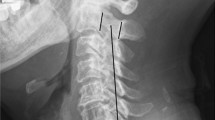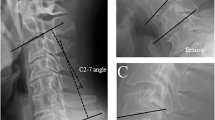Abstract
Purpose
Addition of posterior instrumented fusion to laminoplasty (posterior decompression with instrumented fusion: PDF) can improve the surgical outcome of patients with K-line (−) cervical ossification of the longitudinal ligament (OPLL) compared with laminoplasty alone. We sought to elucidate the factors that are significantly associated with a better outcome after PDF for K-line (−) OPLL.
Methods
The present study included 38 patients who underwent PDF for K-line (−) OPLL and were followed up for at least 1 year after surgery. Clinical outcome was assessed using Japanese Orthopedic Association (JOA) scores for cervical myelopathy and the recovery rate was calculated. Patients who belonged to the upper quartile of all the patients according to rank order of the JOA score recovery rate were considered to have a good outcome. The correlations between good outcome, patient factors and imaging assessments were analyzed statistically.
Results
Univariate analyses showed that postoperative conversion of K-line from (−) to (+) (p = 0.004), no increase in the sagittal vertical axis from the center of gravity of the head to C7 (p = 0.07), and a lower grade of preoperative intramedullary T2-signal intensity (p = 0.03) were candidates for the association. Stepwise logistic regression analysis revealed that postoperative K-line conversion from (−) to (+) is an independent factor that is significantly associated with a better surgical outcome (p = 0.04).
Conclusion
Postoperative K-line conversion from (−) to (+) is a factor independently associated with a better surgical outcome.
Graphical abstract
These slides can be retrieved under Electronic Supplementary material.



Similar content being viewed by others
References
Matsumoto M, Chiba K, Toyama Y (2012) Surgical treatment of ossification of the posterior longitudinal ligament and its outcomes: posterior surgery by laminoplasty. Spine 37:E303–E308
An HS, Al-Shihabi L, Kurd M (2014) Surgical treatment for ossification of the posterior longitudinal ligament in the cervical spine. J Am Acad Orthop Surg 22:420–429. https://doi.org/10.5435/JAAOS-22-07-420
Aita I, Hayashi K, Wadano Y, Yabuki T (1998) Posterior movement and enlargement of the spinal cord after cervical laminoplasty. J Bone Jt Surg Br 80:33–37
Sodeyama T, Goto S, Mochizuki M et al (1999) Effect of decompression enlargement laminoplasty for posterior shifting of the spinal cord. Spine 24:1527–1531
Sakai K, Okawa A, Takahashi M et al (2012) Five-year follow-up evaluation of surgical treatment for cervical myelopathy caused by ossification of the posterior longitudinal ligament: a prospective comparative study of anterior decompression and fusion with floating method versus laminoplasty. Spine 37:367–376
Nishida N, Kanchiku T, Kato Y et al (2014) Biomechanical analysis of cervical myelopathy due to ossification of the posterior longitudinal ligament: effects of posterior decompression and kyphosis following decompression. Exp Ther Med 7:1095–1099
Iwasaki M, Okuda S, Miyauchi A et al (2007) Surgical strategy for cervical myelopathy due to ossification of the posterior longitudinal ligament: part 1: clinical results and limitations of laminoplasty. Spine 32:647–653
Fujimori T, Iwasaki M, Okuda S et al (2014) Long-term results of cervical myelopathy due to ossification of the posterior longitudinal ligament with an occupying ratio of 60% or more. Spine 39:58–67
Fujiyoshi T, Yamazaki M, Kawabe J et al (2008) A new concept for making decisions regarding the surgical approach for cervical ossification of the posterior longitudinal ligament: the K-line. Spine 33:E990–E993
Fujiyoshi T, Yamazaki M, Okawa A et al (2011) Outcome of posterior decompression surgery for cervical OPLL patients of the K-line (−) group: laminoplasty versus posterior decompression with instrumented fusion. J Spine Res 2:231–235
Koda M, Mochizuki M, Konishi H et al (2016) Comparison of clinical outcomes between laminoplasty, posterior decompression with instrumented fusion, and anterior decompression with fusion for K-line (−) cervical ossification of the posterior longitudinal ligament. Eur Spine J 25:2294–2301
Japanese Orthopaedic Association (1994) Scoring system for cervical myelopathy. Nippon Seikeigeka Gakkai Zasshi 68:490–503 (in Japanese)
Hirabayashi K, Toyama Y (1997) Choice of surgical procedure for cervical ossification of the posterior longitudinal ligaments. In: Yonenobu K, Sakou T, Ono K (eds) ossification of the posterior longitudinal ligament. Springer-Verlag, Tokyo, pp 135–142
Tsuyama N (1984) Ossification of the posterior longitudinal ligament of the spine. Clin Orthop Relat Res 184:71–84
Saito J, Maki S, Kamiya K et al (2016) Outcome of posterior decompression with instrumented fusion surgery for K-line (−) cervical ossification of the longitudinal ligament. J Clin Neurosci 32:57–60
Yukawa Y, Kato F, Yoshihara H et al (2007) MR T2 image classification in cervical compression myelopathy: predictor of surgical outcomes. Spine 32:1675–1678
Yoshii T, Sakai K, Hirai T et al (2016) Anterior decompression with fusion versus posterior decompression with fusion for massive cervical ossification of the posterior longitudinal ligament with a ≥ 50% canal occupying ratio: a multicenter retrospective study. Spine J 16:1351–1357
Liu X, Chen Y, Yang H et al (2017) Expansive open-door laminoplasty versus laminectomy and instrumented fusion for cases with cervical ossification of the posterior longitudinal ligament and straight lordosis. Eur Spine J 26:1173–1180
Denaro V, Longo UG, Berton A et al (2015) Favourable outcome of posterior decompression and stabilization in lordosis for cervical spondylotic myelopathy: the spinal cord “back shift” concept. Eur Spine J 24(Suppl 7):826–831. https://doi.org/10.1007/s00586-015-4298-y
Takenaka S, Nagamoto Y, Aono H, Kaito T, Hosono N (2016) Differences in the time of onset of postoperative upper limb palsy among surgical procedures: a meta-analysis. Spine J 16:1486–1499. https://doi.org/10.1016/j.spinee.2016.09.014
Katsumi K, Yamazaki A, Watanabe K et al (2012) Can prophylactic bilateral C4/C5 foraminotomy prevent postoperative C5 palsy after open-door laminoplasty? a prospective study. Spine 37:748–754
Wu FL, Sun Y, Pan SF et al (2014) Risk factors associated with upper extremity palsy after expansive open-door laminoplasty for cervical myelopathy. Spine J 14:909–915
Kurakawa T, Miyamoto H, Kaneyama S et al (2016) C5 nerve palsy after posterior reconstruction surgery: predictive risk factors of the incidence and critical range of correction for kyphosis. Eur Spine J 25:2060–2067
Author information
Authors and Affiliations
Corresponding author
Ethics declarations
Conflict of interest
All the co-authors have no conflict of interest in the present study.
Electronic supplementary material
Below is the link to the electronic supplementary material.
Rights and permissions
About this article
Cite this article
Koda, M., Furuya, T., Saito, J. et al. Postoperative K-line conversion from negative to positive is independently associated with a better surgical outcome after posterior decompression with instrumented fusion for K-line negative cervical ossification of the posterior ligament. Eur Spine J 27, 1393–1400 (2018). https://doi.org/10.1007/s00586-018-5505-4
Received:
Accepted:
Published:
Issue Date:
DOI: https://doi.org/10.1007/s00586-018-5505-4




